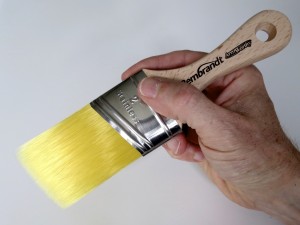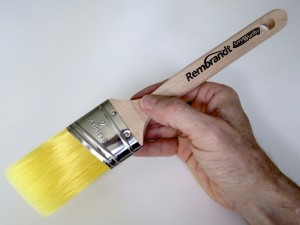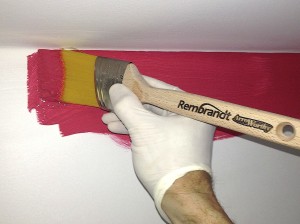Rembrandt angular sash brushes
Rembrandt angular sash brushes are synthetic bristled paint brushes designed for applying both oil-based and water-based paints. The angled design of the brush also lends itself to trying to provide the best and most accurate finish possible, when cutting in around the edges of walls, ceilings and indeed woodwork. Synthetic bristle brushes, as a category, have become the first choice for many tradesmen and DIY enthusiasts, especially when applying water-based paints such as emulsion for walls and ceilings, with nearly all the major manufacturers now making synthetic bristle brushes in varying degrees of quality. So the big question is where do these angled Rembrandts fit into this picture, and after I was given the opportunity for a ‘test-drive’, below are my thoughts on whether you should be rushing out to buy some.
Rembrandt brush range

Rembrandt with stubby short handle.
As with most paint brush ranges, you get different sizes, but with the Rembrandt angular sash brushes, you also get different handle designs with short stubby options as well as longer handled versions – more on this point later.
The basic quality of build is as robust as paint brushes get, the pretty yellow bristles make them easily identifiable, and the semi-oval angled design is the key factor in how the brush actually performs.
Why the angle?
Why indeed?……which has always been my general opinion of angled brushes as I’ve always had (and I stress had!) the feeling that this was a gimmick that convinces consumers that you have to have an angled brush, as it will make it easier to cut in into corners. Well, quite frankly, decorators and DIYers have managed for very many years, using a traditional straight cut brush, without a problem, and I can remember in the distant past trying what must have been a ‘first generation’ angled brush, finding it difficult and slow to use, as well as providing a pretty poor finish – in hindsight, what should I have expected from what was basically a straight cut brush which someone had hacked bristles off at far too acute an angle.
The Rembrandt angular sash brush however, bears little resemblance to earlier generations of angled brush, and instead, I found it to be a beautifully designed tool for applying paint. The slight angle of cut and taper on the bristles certainly makes it easy to get into corners and cut in, in a straight line.
Rembrandt in use

Rembrandt with long handle – my preference.
I gave both the stubby and long handled versions a run out to see which I preferred. I thought I’d be opting for the compact nature of the stubby design, but in practice I actually found the long handled version seemed to be better balanced, and sit more comfortably in the hand. The stubby would come into its own when space is limited – such as between shelves in a wardrobe, for example.

Cutting in wall colour to ceiling using a Rembrandt with a long handle.
As you can see from the photo bottom right, I actually used it with an incredibly strong colour, so that any mistakes in cutting in would stand out like the proverbial.
I honestly have to say that I think the brush design made it very easy to cut in a precise straight line.
I’m not saying you have to have a Rembrandt to cut in accurately as the job can be done perfectly well with a good quality straight cut brush, but I suppose it’s a bit like driving an automatic car compared to a manual one – in both cases you’ll get to where you want to, but the ‘automatic’ Rembrandt simply requires less effort.
Keeping the angled bit aside, I think it’s also worth mentioning that the quality of the bristles, with the oval design, not only seem to allow you to hold quite a lot of paint on the brush when you load it, but also provides and excellent finish as you distribute the paint on the wall surface and lay it off.
Where to buy
Therefore, all said, I have no hesitation in recommending the Rembrandt range. They’re not a cheap option (quality never is!), but I also don’t think they’re particularly expensive, and if you’ve been using let’s say, ‘average’ quality brushes up to now, you’ll definitely see the difference when you try using a Rembrandt.
Rembrandts have come across the pond from the States, like many of the top quality paint brush options, and so you won’t find them on the shelves of DIY sheds, or even most trade suppliers. However, you can purchase Rembrandts at mypaintbrush.co.uk where you can view the full range, along with a number of other quality decorating products, which may also catch your eye. On your next DIY home decorating project, consider giving a Rembrandt a go, you won’t regret it!

Hi Julian,
Good, detailed blog! I am a real convert to angled brushes – yes, you can cut in with a straight brush but it’s so much easier and quicker with a good angled brush. Have you tried the Picasso brushes, also from MyPaintbrush.co.uk. Personally I find them even better than the Rembrandt for all but the thickest emulsions – they have less spring in the filament. But favourite brushes can be a very subjective thing! What is true is that the choice of quality brushes has never been so good in the UK!
Hi Charles,
Thanks for the comments, and yes, Picassos are on my list for reviewing in the not too distant future.
Best,
Julian